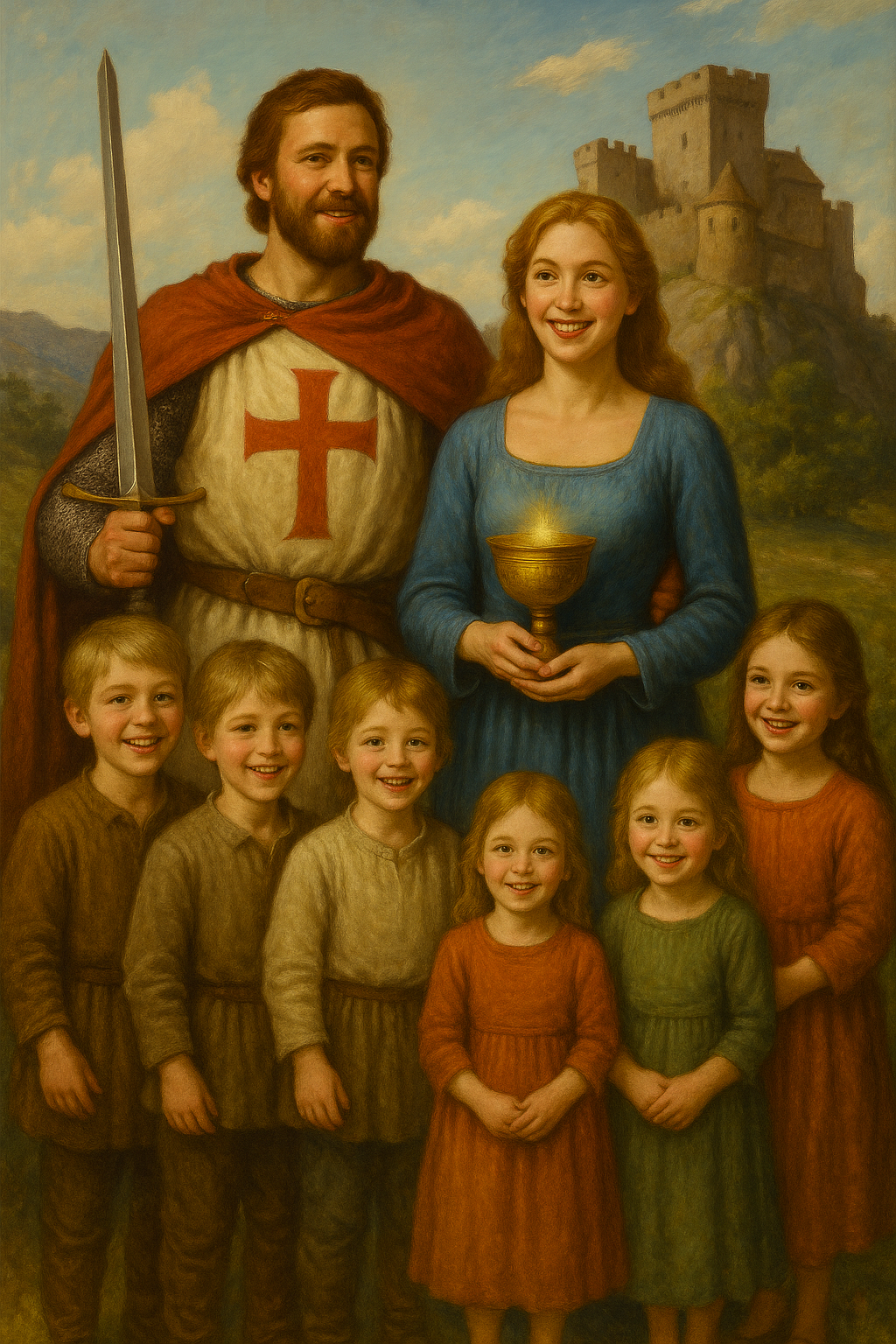The basic religious need – Why the mystical needs a form and the rediscovery of the sacred in everyday life
Our age considers itself enlightened. People believe they can live without God, without prayer, without ritual – and yet a void remains that no technology, no freedom, and no knowledge can fill. For every human being carries within them a fundamental religious need – the urge to connect with the eternal, to find meaning, to touch the sacred.
This need can be repressed, but not extinguished. And when the connection to the divine is lost, the soul unconsciously seeks a substitute – in ideologies, in passions, in images of power or the ego.
Therefore, a return to religious form is not a regression, but rather the restoration of the inner order without which humanity itself decays.
The Nigredo Monastery reminds us that the sacred does not lie outside, but can be experienced in the form of everyday life – in prayer, in the family, in work, in silence, and in love.
1. The Inextinguishable Need
In the innermost being of every human being lies an invisible thirst – the desire to connect with the eternal. Whether we call it God, origin, truth, or meaning – the soul longs for that which transcends it. C. G. Jung recognized in this longing not a cultural tradition, but a spiritual necessity:
The religious instinct is as primal as hunger or the sexual drive.
The sacred is to the soul what bread is to the body. If it is lacking, man hungers – and seeks a substitute.
2. When the sacred is repressed
Where the sacred is lacking, substitute gods arise. Man continues to pray, but no longer to God, but to his own images: to success, to the self, to technology, to power.
Thus, the basic religious need becomes sick. What was originally intended to bring healing becomes obsession. The cult remains, but the center is missing.
That's why Jung warned:
If humanity no longer directs the divine upwards, it returns downwards – as delusion, greed, or ideology.
3. The Mystical Needs Form
Many today seek the mystical, but without religion, without order. They want to experience light, but not walk through darkness. They want transcendence, but without obedience.
But the formless does not sustain. The fire of the spirit needs a hearth, otherwise it burns.
The mystical must be bound – not to bind it, but to preserve it.
That's why forms of faith are needed:
- the grace before meals, which sanctifies everyday life,
- the Sunday Mass, which orders time,
- the sign of the cross, which binds the body in prayer.
These forms are not empty, but vessels in which the invisible takes shape. Without them, the soul loses itself in moods.
The mystical without religion is like water without a source – it evaporates.
4. Everyday Religious Life
Everyday religious life is not a regression, but the healing of the inner conflict of modern man.
- When a person prays before eating, they remember that food is a gift, not a possession.
- When they sanctify Sunday, they remember that time does not belong to them, but to God.
- When they begin the day with a sign of faith, they place their life in the order that transcends them and yet sustains them.
Thus, everyday life becomes a place of the sacred once again—not through ecstasy, but through faithfulness.
5. Nigredo Monastery – The Vessel of Transformation
Nigredo Monastery represents the rediscovery of this spiritual order. It teaches that the divine is not found in fleeing from the world, but in imbuing it with meaning.
The Nigredo, the dark phase of transformation, is the moment in which man recognizes his own formlessness. He learns that freedom without order is not freedom,
but decay.
That is why the Nigredo Monastery creates space for religious experience in everyday life: prayer, silence, work, celebration – everything becomes liturgy, a movement between heaven and earth.
Here, the mystical is not sought, but lived. Not outside of form, but within it.
6. The Family as a Place of the Sacred
The first and oldest monastery of humanity is the home. In it, people pray, argue, forgive, and love. In it, the sacred is revealed not in symbols of stone, but in the way people interact with one another.
The family is the vessel in which life is renewed. When a man and a woman turn to each other in faithfulness, their love becomes an image of creation itself: it sustains, it nourishes, it imparts life – not only in the body, but in the spirit.
The marriage bond is a spiritual school: it teaches patience, humility, sacrifice, and joy.
It sanctifies what happens between people because it is not just a feeling, but a decision—a daily affirmation of responsibility, of devotion, of the shared path.
Thus, the family becomes a place of holiness, where piety is visible not in words but in deeds.
7. Love, Fidelity, and the Inner Form
True love is not possession, but participation. It is a Working together in the creative mystery of life. When tenderness is borne by respect and closeness grows from responsibility, the human becomes permeable to the divine.
The family thrives on piety – on the awareness that every action has its place, every action has an effect, and that love deepens the more it forgets itself.
Thus, relationships, parenthood, and everyday life become a silent liturgy in which the divine shines through in the human.
8. Morality – The Forgotten Form of the Soul
Our age talks a lot about spirituality, but avoids the word morality. People seek experience without obligation, feeling without law, and call it freedom.
But without morality, there is no freedom – only arbitrariness.
Morality is not the opposite of spirituality, but its root. It gives direction to the spirit, just as a vessel gives form to water.
C. G. Jung wrote that the soul can only unfold where an ethical order holds it. Without it, the spiritual disintegrates into mood, and the sacred loses its seriousness.
What we often call "spiritual" today is often an escape from the demands of ethics. Yet it is precisely ethics—virtue, discipline, respect—that is the fertile ground upon which the soul thrives.
Therefore, we must return to morality as a spiritual framework: not as coercion, but as protection. Not as a set of rules against life, but as an order that sustains life.
Only those who respect inner laws can encounter the truth without being destroyed by it.
9. The Family—Source of Life and the Future
In the family, the mystery of life is passed on. Here, love receives its creative meaning—it does not remain in itself, but opens itself to what is to come.
Children are not coincidences, but signs of divine providence. In them, life itself says "yes" to the parents, just as the parents previously said "yes" to each other. Thus, the family becomes a place of hope, where life is renewed and trust is learned.
In our tradition, marriage is more than a covenant—it is a sacrament, a visible sign of divine grace. Where a man and a woman meet each other faithfully and accept the life given to them, there the love of God can be experienced.
For this reason a man shall leave his father and mother and be joined to his wife,
and the two shall become one flesh. (Eph 5:31)
True love is always creative. It does not merely seek pleasure or self-affirmation, but grows through responsibility (the desire for children), faithfulness, and devotion. Physical union only finds meaning when it is sustained by the soul and open to life. For love that closes itself becomes empty, castrated, and sterile—but love that gives itself becomes fruitful, both spiritually and physically. And so the desire for children is fundamental to marriage.
Thus, sexuality becomes not an end in itself (masturbation), but a sign of God's creative love, which brings forth, sustains, and transforms life (children).
Therefore, true chastity does not involve repression, but awareness: that every union is a call to responsibility – before God, before others, before life itself.
The holier marriage and the family, the holier the land that springs from them becomes. For it is there that the seeds of the future are sown – in devotion, in patience, in responsibility for one another.
Children are the blessing that remains when all else passes away. They are the visible sign that life continues, that love never ends, and that God continues to work in the family.
This is why the Nigredo Monastery prays:
May God grant our families the courage to be open to life, joy in responsibility, and trust in divine guidance.
Bless fidelity, bless sorrows, bless the path that fathers and mothers take together! It can often be difficult for parents to summon the courage to have children. Let them say a courageous "yes"! Don't let their goodwill falter, don't let their joy in sacrifice cool, and send them the happiness of domestic peace.
Behold, children are a gift from the Lord, the fruit of the womb is his bounty. (Psalm 127:3)
10. The Sanctification of Form
Jung wrote:
Only in a religious attitude can a person encounter his own soul without being broken.
The religious framework—prayer, ritual, confession—is not a cage, but an altar upon which the soul may bow without losing itself.
That is why the world today doesn't need new religions, but rather lived forms of faith: an everyday life that is once again sacred, a time that once again knows rhythm, a language that once again knows thanks.
For the sacred is not only meant to be thought about, but lived—in the rhythm of the day, in the sign of the hands, in the prayer of the heart.
11. Conclusion
The fundamental religious need is the heart of the soul. If it cannot find a form, it seeks one.

